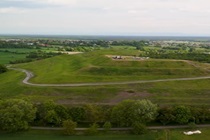 The Polish Geological Institute – National Research Institute carries out the task of the state geological service entitled ‘Balance of anthropogenic resources in Poland – stage I’. The aim of this project is to start systematic balancing of anthropogenic resources deposited in post-mining waste heaps as a potential source of mineral raw materials.
The Polish Geological Institute – National Research Institute carries out the task of the state geological service entitled ‘Balance of anthropogenic resources in Poland – stage I’. The aim of this project is to start systematic balancing of anthropogenic resources deposited in post-mining waste heaps as a potential source of mineral raw materials.
Pilot activities are being carried out in the Silesian Voivodship, a region where there is a concentration of such sites.
The Polish Geological Survey conducts its own exploratory drilling. One of the first sites for such activities was the Marta Waleska coal waste tip, covering an area of 18 hectares and reaching a height of 40 metres. It was created between 1994 and 2007 as a result of the storage of waste rocks, sludge and post-production waste from the nearby ‘Bolesław Śmiały’ coal mine.
Between 2013 and 2022, the Polish Geological Survey conducted an inventory of 1,382 post-mining sites in Poland. It is estimated that over 1 billion cubic metres of industrial waste, which may contain valuable natural resources, has been deposited at these sites. Heaps and dumps created as a result of many years of mining activity may contain metals, energy elements, raw materials for construction, road building, railways and the ceramics industry. Their reuse is in line with the growing demand for raw materials and the limited access to natural resources.
So far, research in Poland has focused on analysing individual waste heaps. The current project will allow for a transition from local activities to comprehensive balancing of anthropogenic resources at the voivodship level and, ultimately, at the national level. A key element of these activities will be detailed geological reconnaissance, which is necessary to assess the quality and quantity of deposited raw materials.














 PGI-NRI offer
PGI-NRI offer Mineral resources of Poland
Mineral resources of Poland  Oil and Gas in Poland
Oil and Gas in Poland 




 Subscribe to RSS Feed
Subscribe to RSS Feed